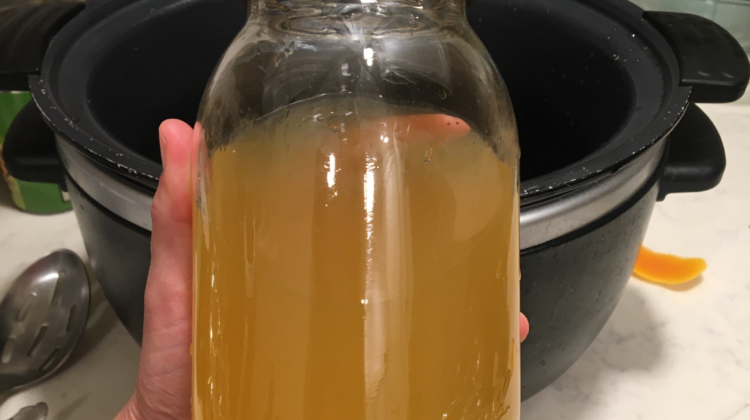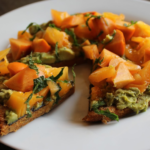
This citrus peel extract tonic is a great way to get limonene into your diet. It’s also great during a Daniel Fast. You’ll want to use a slow cooker. Keep reading for the recipe and equipment recommendations.
YouTube Video
Watch the video of this recipe on YouTube:
What is citrus peel (limonene) tonic recipe?
There are many health benefits to consuming citrus peel extracts (essential oils) which are plentiful in the peels of citrus fruit. Particularly, citrus peels contain d-limonene which many people take as a supplement.
However, you can make a tonic, or beverage, packed with d-limonene by heating the peels in water for a long period of time. Then, strain the peels and reserve the liquid tonic.
Health benefits of citrus peel limonene extracts
According to the National Institute of Health,
Citrus fruit and in particular flavonoid compounds from citrus peel have been identified as agents with utility in the treatment of cancer.
Citrus fruits such as mandarin, pomelo, orange, lime, lemon, and grapefruit have been recognized as having high contents of bioactive compounds (1). Between the pulp and the peel, such fruits contain folate, vitamin C, dietary fiber, and bioactive compounds such as flavonoids. Flavonoids are widely distributed in aromatic plants such as mint and tea but are present in high concentrations in citrus fruits and their peels (2).
Citrus peel has untapped potential as a source of medicinal compounds because it contains carotenes, essential oils, pectin, and a range of polyphenolic compounds (3). Epidemiological studies have suggested that high consumption of fruits and vegetables (>400 g/d) can reduce cancer risk by ≥20% (4). The Mediterranean diet is rich in fruit pulp and juice, and the associated high intake of fiber, antioxidants, and polyphenol compounds is linked with a lower cancer risk (5, 6).
Apart from the above bioactive compounds, d-limonene is the primary essential oil in citrus peel (75) with anticancer activity in humans (76).
Organic citrus

It’s ideal to only use organic citrus fruit in this recipe.
Cleaning citrus fruit
I like to use some drops of Grapefruit Seed Extract in filtered water to clean the citrus peels. Make sure to clean off any dirt and residue from the peels because you will be consuming whatever is on the peels for this recipe.
Shop for Grapefruit Seed Extract on Amazon.
Tips
- Do not boil. Use slow cooker to prevent boiling.
- Wash citrus well in filtered water with about 10 drops of Grapefruit Seed Extract.
- Use a high quality serrated knife, such as Wusthof brand.
- I recommend using a GreenLife slow cooker.
Here’s the recipe and affiliate links to Amazon for recommended meal prep equipment:
Citrus peel (limonene) tonic recipe

- Makes about 3 cups limonene tonic
- Cook time: 3 hours in slow cooker
Equipment
- GreenLife slow cooker
- Wusthof serrated knife
- Ball glass jar with lid
- Cutting board
- Norpro jar funnel
- Winco metal mesh strainer
- Metal tongs
Ingredients
- 10 drops Grapefruit Seed Extract, for washing citrus fruit
- 4 organic grapefruit, peeled
- 1 organic lemon, peeled
- 4 cups filtered water
Directions

- Peel or cut off peels from grapefruits and lemon. Reserve the inside of the fruit for Citrus Smoothie recipe.
- Place the peels into a slow cooker pot.
- Pour about 4 cups filtered water over the peels.
- Place pot into slow cooker. Set to High heat for 3 hours. Cover with lid and let cook.
- After 3 hours, remove the lid and let tonic cool down.
- Sanitize a glass jar and lid by placing into boiling hot water for a few minutes. Also sanitize tongs, jar funnel and strainer in the boiling hot water.
- Place jar funnel into top of jar. Place small strainer over funnel.
- Pour tonic water and peels through the strainer, reserving the liquid in the jar. Press excess liquid out of peels.
- Discard peels.
- Cover jar and store in the refrigerator for 1 week. Or, pour into ice cube trays and freeze for about 1 month.
Serving

Enjoy 2-4 ounces of this limonene tonic each day. Ideally, some in the morning and then again in the evening.
Variations
Substitute any organic citrus, such as oranges, tangerines, pomelos, and limes.
Further reading:




